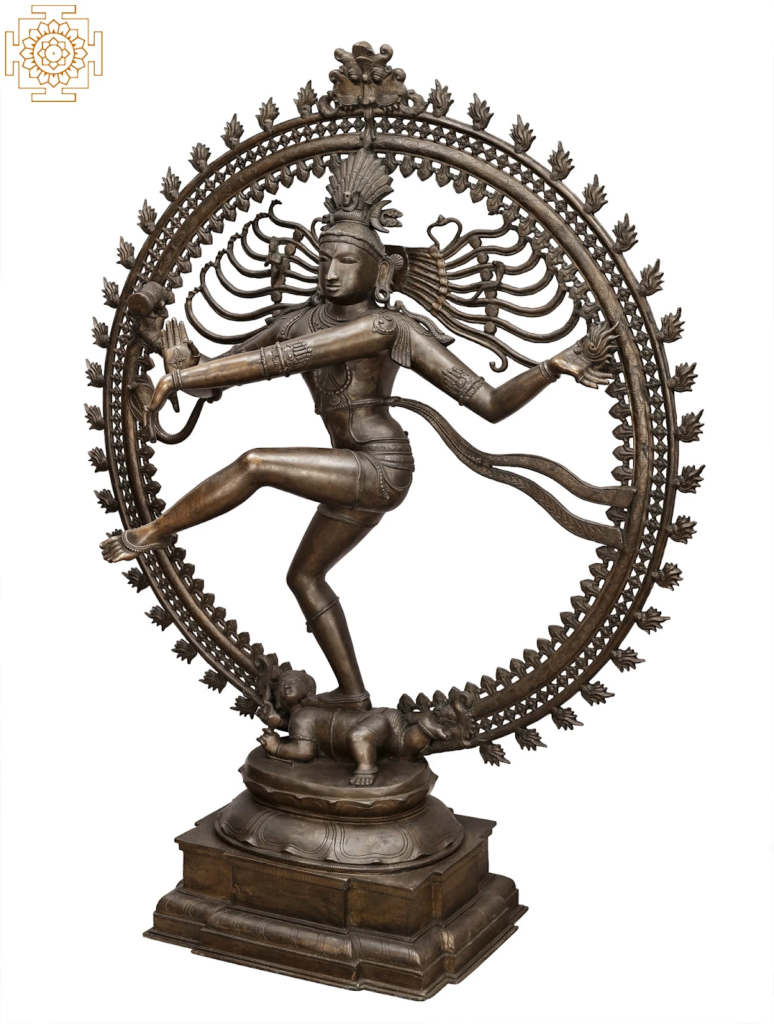This is Day 20 | 90 Days RAS Mains 2025 Answer Writing, We will cover the whole RAS Mains 2025 with this 90-day answer writing program
Click here for the complete 90 days schedule (English Medium)
Click here for complete 90 days schedule (Hindi Medium)
GS Answer Writing – Fine Art, Performing Art, Architecture & Literature from Indus Civilization to British Era। पत्र लेखन
The sculpture depicts Lord Shiva in his cosmic dance, known as the “Ananda Tandava,” symbolizing the eternal rhythm of creation, preservation, and destruction. Notable features include :

- Shiva is balanced on his right leg and and suppressing the apasmara, the demon of ignorance
- His left leg is raised in a bhujangatrasita stance which represents tirobhava, that is kicking away the veil of maya (illusion)
- Four arms: Right hand in Abhaya hasta (gesture suggesting fearlessness), upper right holds damaru (musical instrument), left hand in dola hasta (connects with Abhaya hasta), upper left carries a flame.
- The matted and flowing locks of Shiva represent the flow of river Ganges
- The Nataraja is surrounded by a nimbus of glowing lights ( symbolising the vast unending cycles of time)
Although Asoka embraced Buddhism and took efforts to spread Buddhism, his policy of Dhamma was a still broad concept. His principles of Dhamma were clearly stated in his Edicts. main features may be summed as follows:

Therefore, Ashoka’s dhamma was a way of life, a code of conduct, and a set of principles to be adopted and practiced by the people at large.His Dhamma is so universal that it appeals to promote the welfare of humanity even today.
Note 👍
- He did not equate Dhamma with Buddhist teachings. Buddhism remained his personal belief.
The Mughal architecture is a blend of Indian, Persian, and Turkish styles, encompassing forts, palaces, mosques, mausoleums, public buildings, and gardens. Akbar’s era particularly stands out for its extensive construction projects.
Principal Features of his reign:
- Blending indigenous styles with Persian, Central Asian, and Timurid influences.
- Use of redstones and marble
- Introduction of “Tudor arch” (four-centred arch)
Some of the Prominent works:
- Forts: He built many forts → Agra Fort was built in red sandstone (inside the garden – char bagh style). His other forts are at Lahore and Allahabad, ajmer (Magazine fort)
- Fatehpur Sikri: described as a “frozen moment in history” as buildings are a unique blend of Hindu and Persian styles
- It is a palace cum-fort complex at Fatehpur Sikri (City of Victory.
- Many buildings in Gujarathi and Bengali styles are found in this complex.
- The most magnificent building in it is the Jama Masjid and the gateway to it is called Buland Darwaza or the Lofty Gate. The height of the gateway is 176 feet. It was built to commemorate Akbar’s victory over Gujarat.
- Other important buildings at Fatepur Sikri are Jodh Bai’s palace and Panch Mahal with five storeys, ibadat khana, Diwan-I-Aam, Diwan-I-Khas, tomb of salim chisti
- the Humayun’s tomb was built at Delhi and it had a massive dome of marble. It may be considered the precursor of the Taj Mahal.
- Nilkanth Temple or Imarat-i-Dilkhusha (the heart-pleasing abode) is a temple built on the orders of Mughal Emperor Akbar by the governor of Mandu, Shah Badgah in 1574 AD.
- Raja Man Singh and Akbar built a temple of Govind Dev in Vrindavan.
In conclusion, Akbar’s impact on Mughal architecture is evident in the demonstration of a seamless integration of various cultural influences.
Paper 4 (Comprehension part) – पत्र लेखन

Day 19 | 90 Days RAS Mains 2025 Answer Writing

